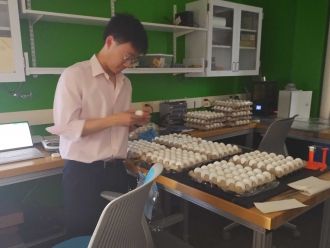Media release
From:
Eggs less likely to crack when dropped side-on
Eggs are less likely to crack when dropped on their side than when dropped vertically, finds research published in Communications Physics. Controlled trials simulating the ‘egg drop challenge’, a common classroom science experiment, found that the shell of an egg can better withstand an impact when dropped side-on.
The goal of the ‘egg drop challenge’ is for students to prevent an egg from cracking when dropped from a set height. A common belief is that an egg is stronger and less likely to crack when dropped vertically, with this assumption often seen in teaching guidance from schools and among ‘popular science’ communicators.
Tal Cohen and colleagues conducted a series of 180 drop tests to compare how chicken eggs break when orientated vertically or side-on. After dropping 60 eggs from each of three different heights — 8, 9, and 10 millimetres — on to a hard surface, the authors observed that, on average, eggs dropped vertically broke at lower drop heights. More than half of the eggs dropped vertically from 8 millimetres cracked, with which end of the egg pointed downwards making no difference. However, less than 10 percent of horizontally-dropped eggs cracked from the same height. A further 60 eggs were subjected to compression tests, which measured the force required to crack the eggs vertically and horizontally. While 45 newtons of force was required to break the eggs in both orientations, the horizontally-loaded eggs could compress further before cracking. The authors suggest that this means that eggs are more flexible around their equator, and therefore able to absorb more energy in this orientation before breaking.
The authors conclude that the reason behind the common misassumption that an egg dropped vertically is less likely to crack is a confusion between the physical properties stiffness, strength, and toughness. Eggs are stiffer when compressed vertically, but the authors say that this does not necessarily mean that eggs are also tougher in that direction. The authors also suggest that future research could explore the application of these findings to engineering scenarios, such as how structures respond to dynamic loads.
Multimedia







 International
International



